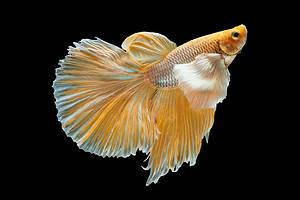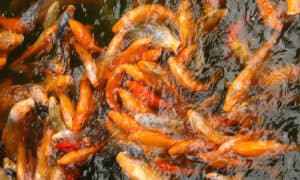Goldfish may be considered a common species of fish today, but once upon a time they were exotic and rare! The Chinese began breeding them 1,000 years ago, eventually producing fish with classic golden scales. In the Song dynasty, only members of the imperial family were permitted to own these gorgeous fish. Today, anyone can own and breed them – and some pet owners do so by accident. If you think your aquatic companion may be carrying babies, you’re probably wondering: how long are goldfish pregnant? Read on for answers to these and other questions about goldfish!
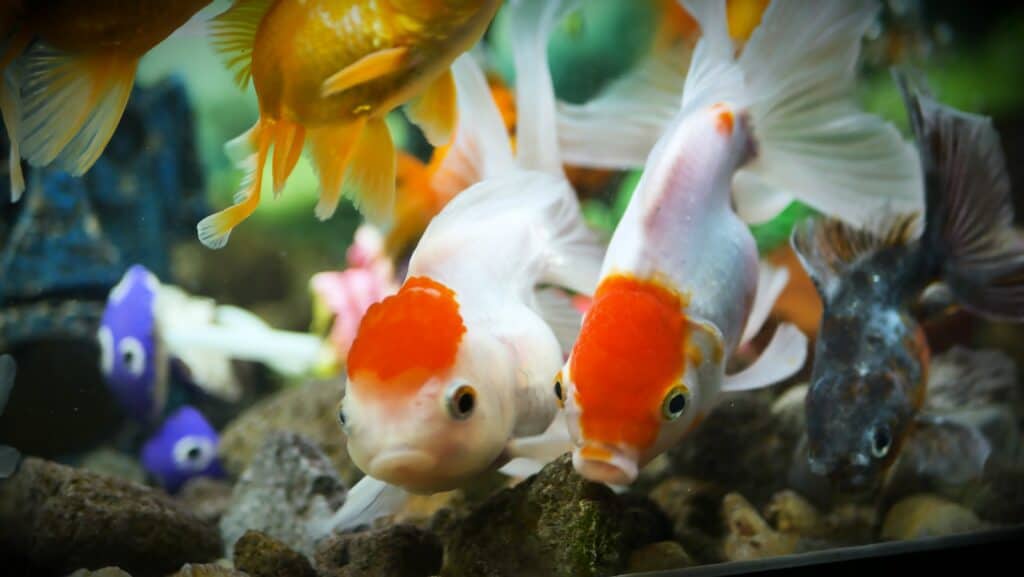
Goldfish are never actually pregnant, as they spawn instead of give birth. They do carry eggs which take 2-7 days to hatch after being deposited and fertilized.
©Last 4ever/Shutterstock.com
Types of Goldfish
Goldfish are a species of carp in the family Cyprinidae with the scientific name Carassius auratus. These ray-finned bony fish live in freshwater habitats both in the wild and as pets. There are about 200 different breeds of goldfish with considerable variation in colour, size, and the number and shape of fins. Goldfish are either single-tailed or double-tailed. They also come in 3 main colour variations: Erythrophores (red), Xanthophores (yellow), and Melanophores (black).
Single-Tailed Goldfish
Single-tailed goldfish are hardy fish that make good starter pets. Simple, streamlined bodies with a single caudal (tail) and anal fin characterize this group. They thrive either in aquariums or outdoor ponds as long as the water is clean with little to no current.
Examples of single-tailed goldfish breeds are:
- Common (feeder) goldfish
- Comet goldfish
- Nymph goldfish
- Shubunkin goldfish
- Tamasaba (Sabao) goldfish
Double-Tailed (Fancy) Goldfish
As the name suggests, this group of goldfish features double caudal and anal fins. Some of them have oversized, delicate eyes. Most look fancier than single-tailed goldfish and require more specialised care, including warmer water. They are slower swimmers than single-tailed goldfish and should not be kept in the same tank, as they won’t be able to compete for food.
Examples of double-tailed goldfish breeds are:
- Fantail goldfish
- Butterfly tail goldfish
- Watonai goldfish
- Veiltail goldfish
- Pearlscale goldfish
Goldfish Appearance and Size
Despite their name, goldfish breeds vary widely in appearance. While some retain the signature orange-gold colour, others are red, white, black, yellow, blue-grey, olive green, yellow, or brown. Wild goldfish tend to be plainer in colour so as to camouflage themselves on lakebeds and riverbeds. Goldfish bred as pets are the most flamboyant and can be very expensive depending on the breed.
Goldfish are small fish well-suited to aquarium life. They usually only grow 1-2 inches long in a domestic setting with a maximum length of 10 inches. In the wild, however, they can grow somewhat larger, up to 12-14 inches. These breeds can weigh up to 9 pounds.
Goldfish Diet and Predators
Goldfish are omnivores, though their prey is necessarily small in size. Their pharyngeal teeth (teeth in the throat) enable them to chew their food. They eat algae, aquatic plants, insects, shrimp, and fish and insect eggs. Pet owners may also feed them manufactured fish food.
Being small and relatively defenseless, goldfish are prey for just about any other carnivorous freshwater creature. Fish like trout and pike will eat goldfish given the chance; they are also prey for birds like kingfishers and herons. In a domestic setting, goldfish in aquariums or outdoor ponds may be targets of cats, dogs, coyotes, and raccoons.
Goldfish Habitat
Goldfish are native to China but have since spread worldwide. In some places, they are an invasive pest. They congregate in fresh bodies of water like ponds, streams, rivers, lakes, and canals. Some have even been found in drainage ditches. Cold, slow-moving, slightly murky water is their habitat of preference. If kept in an aquarium or fishbowl, it is a good idea to lay down a dirt bottom.
Goldfish Social Behaviour
Goldfish are friendly, intelligent fish without much natural aggression. They do well in groups whether in the wild or as domesticated fish. Observers have even seen them playing and napping with each other. As long as the aquarium or pond is not overcrowded, they should get along just fine with other goldfish.
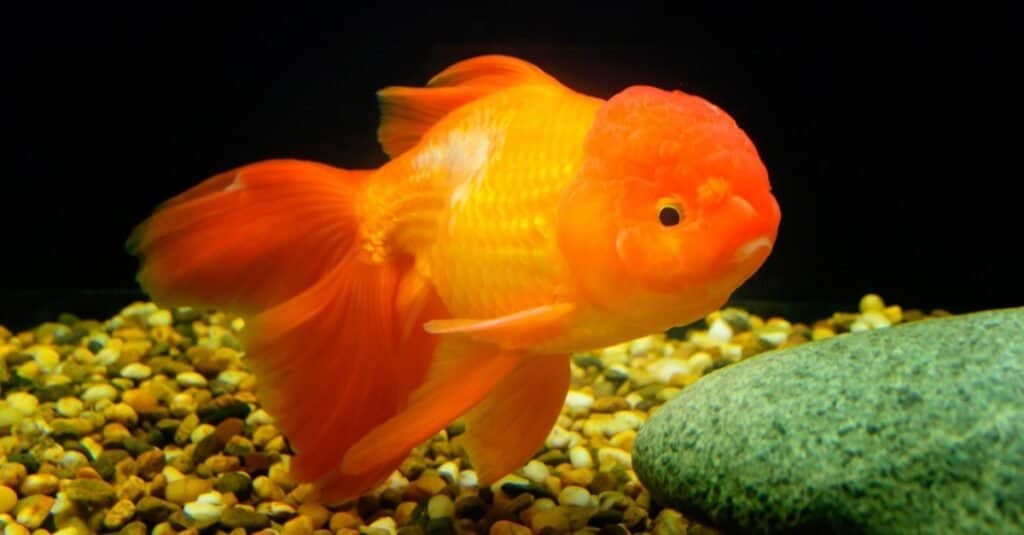
Goldfish can lay up to 1,000 eggs at one time.
©iStock.com/Foto_by_M
Goldfish Reproduction and Lifespan
Goldfish are ovuliparous fish, meaning the fertilization of their eggs occurs outside their body. Female fish with eggs release pheromones to let males know she is ready to spawn. A male will then give chase. Upon catching her, he will nudge her abdomen repeatedly to make her release her eggs. When she does, the male releases his milt (sperm). The sperm fertilizes the eggs, which stick to nearby plants or rocks. This reproductive process is spawning, not mating.
Yolk in the eggs provides the embryos with the necessary nutrition until they’re ready to hatch. They take 2-7 days to hatch depending on the temperature of the water. Warmer water will speed up this process.
Goldfish can live 5-12 years, though some breeds can live up to 30 years.
How Long Are Goldfish Pregnant?
Because goldfish don’t bear live young, they are never technically pregnant. Eggs take 2-7 days to hatch, but neither the female nor the male has any part in this process. In fact, goldfish of both sexes will eat the eggs if they have access to them. For this reason, pet owners should immediately remove fish eggs to a separate environment if they want them to hatch. In the wild, other fish will also eat the eggs given the chance.
How Can You Tell If a Goldfish is Pregnant?
Though goldfish are never actually pregnant, they do carry eggs in preparation for fertilization. There are a few ways to detect if a goldfish is ready to release eggs:
- She has a bulge to one side of her abdomen: A goldfish carrying eggs will not be merely fat, but rather will have a chunky look to her. Because goldfish are voracious eaters, they are often overfed, potentially confusing the matter. Goldfish with eggs will usually appear lopsided, not just chubby.
- Other fish chase her: Males ready to fertilize eggs will pursue a female until she releases them. If your fish look like they are playing tag, they could actually be getting ready to spawn.
- Mating tubercles: Male goldfish in spawning season may have tiny white dots called mating tubercles on their gills and fins. This could indicate that they are ready to fertilize eggs or have already done so.
Squeezing a bulky female goldfish may also cause eggs to be released. However, this method is not recommended for nonprofessionals as it could easily stress or seriously harm your goldfish.
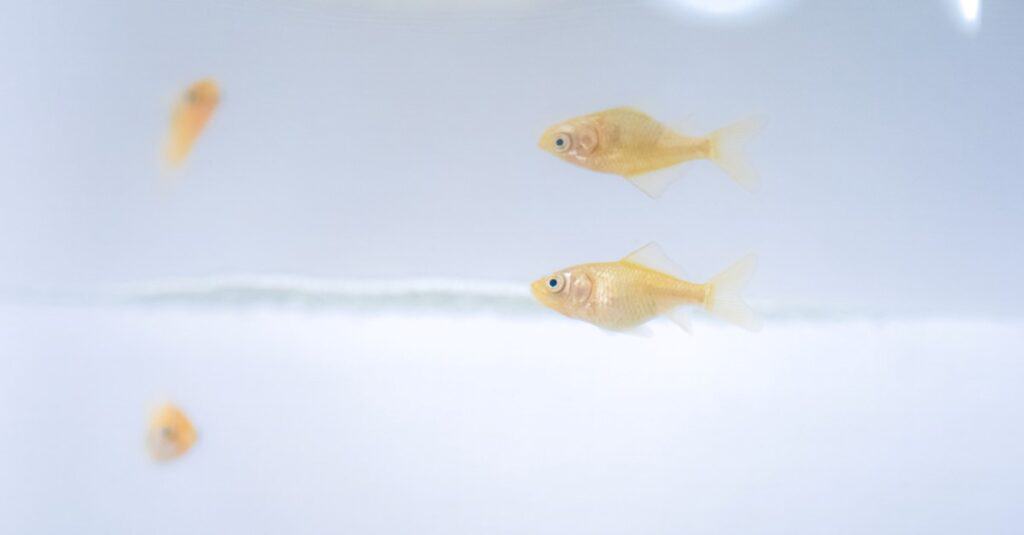
Goldfish eggs and fry may need their own tank to prevent other goldfish from eating them.
©kjnk/Shutterstock.com
How Often Can a Goldfish Get Pregnant?
Goldfish in the wild usually spawn during the warmer months of the year, beginning in spring. They can spawn up to once a month. However, fish kept inside in consistently warm water can do so year-round.
How Many Eggs Do Goldfish Lay?
A female goldfish can lay up to 1,000 eggs at a time. Some eggs will remain unfertilized, and not all the fertilized eggs will hatch. Even among the ones that do, only about 30% will survive, if that. The goldfish larvae will be able to live off the remaining yolk from the eggs for 2-3 days. After that, they will need to find another food source.
If you buy more than one goldfish, be prepared: you may soon be seeing fish eggs or even adorable little fry in your tank!
How Many Goldfish Babies Survive?

Out of 1,000 eggs, only 30% of goldfish fry will make it to adulthood.
©Michelle Jo, Public domain – License
Goldfish babies, called fry, only have a small percentage that will make it to adulthood. Even if you are an experienced fish owner, and give it all the proper care they need, only about 30% will live to the adult stage. The remaining 70% of fry will either die from disease or, for a small percentage, will die from a deformity incurred at birth. This is one of the reasons that goldfish have so many eggs – the majority will never make it to adulthood.
These fry require more specialized care than regular goldfish and need their food and environment to adhere to certain conditions. Without following the proper procedures, your chances of having even 30% remaining will drop.
The photo featured at the top of this post is © iStock.com/satit_srihin
Thank you for reading! Have some feedback for us? Contact the AZ Animals editorial team.



